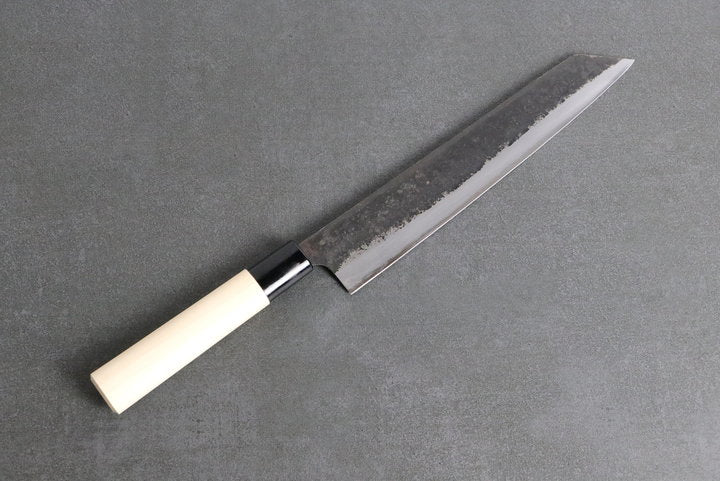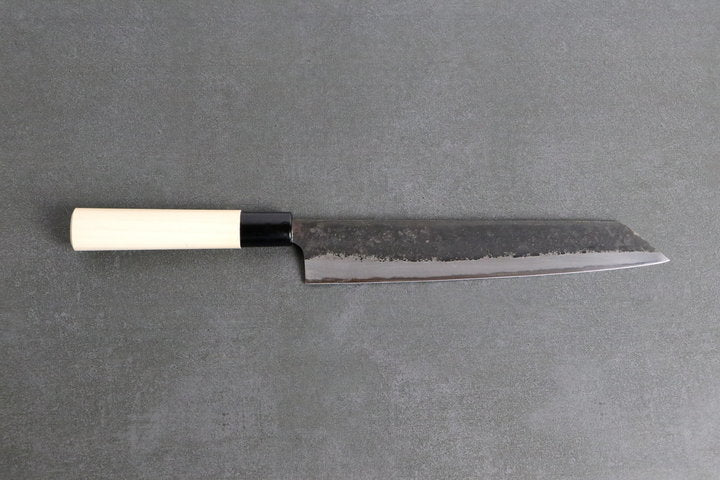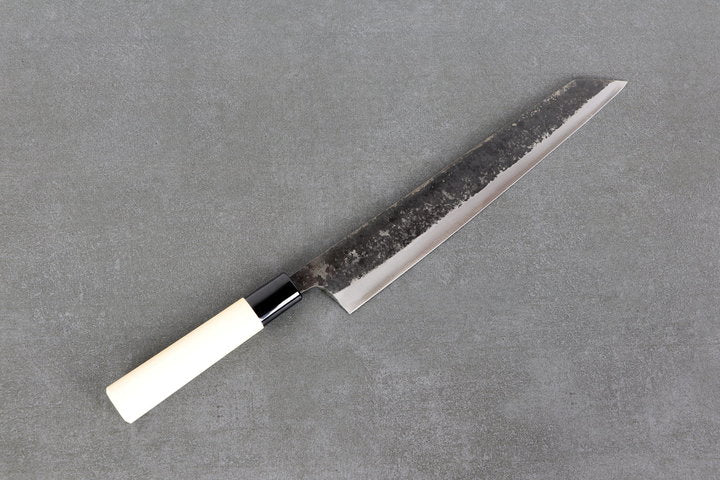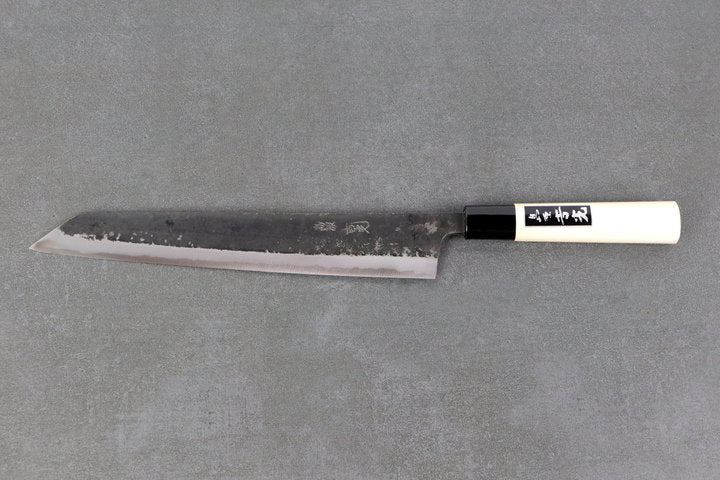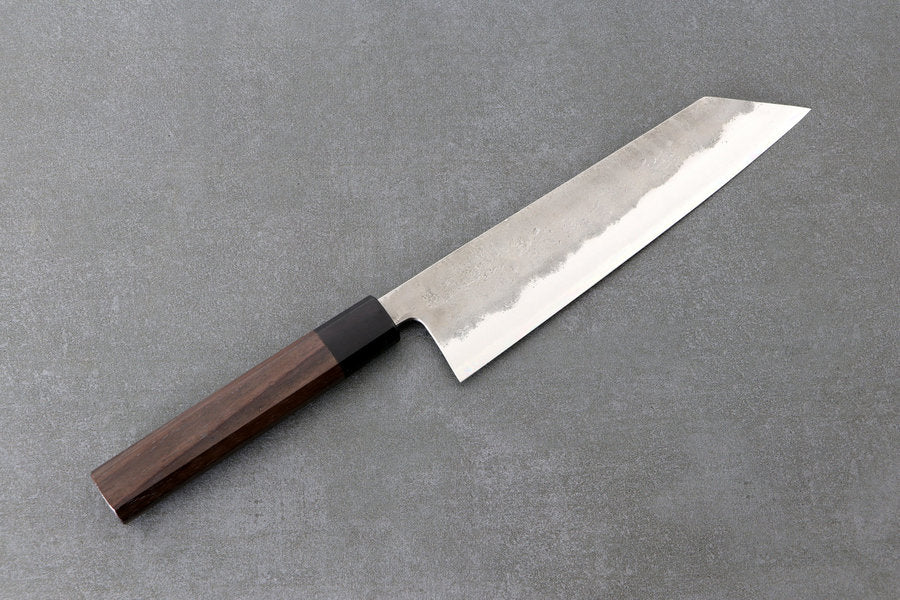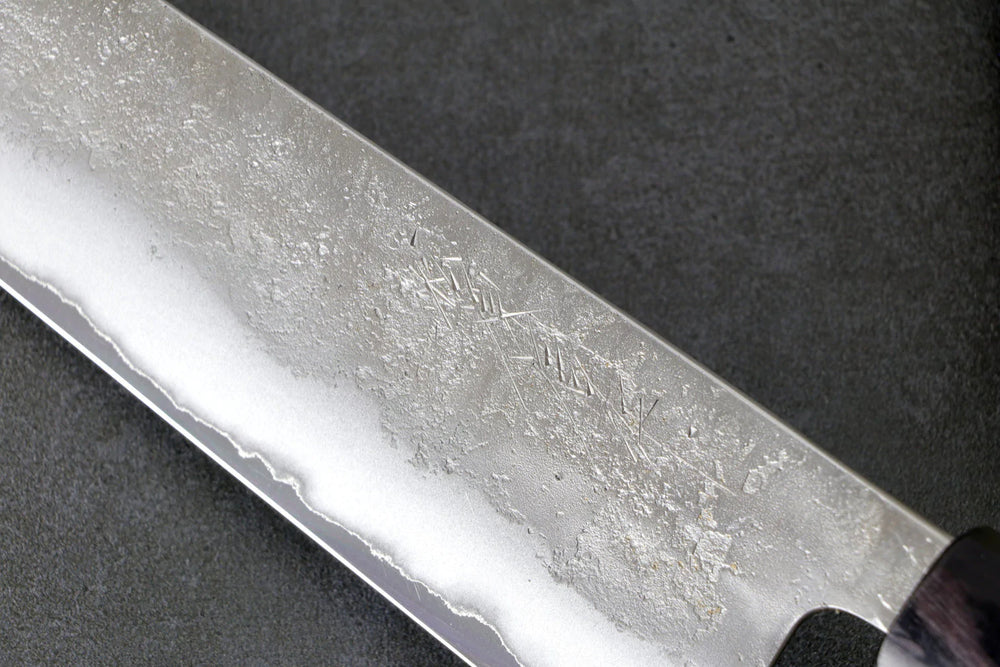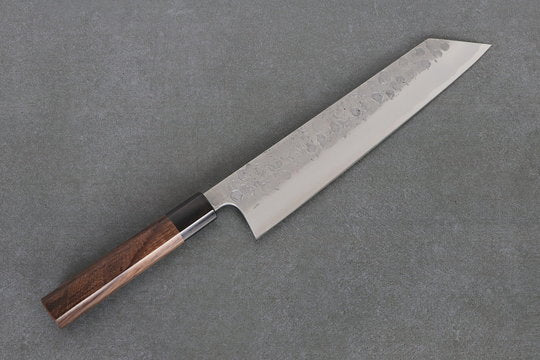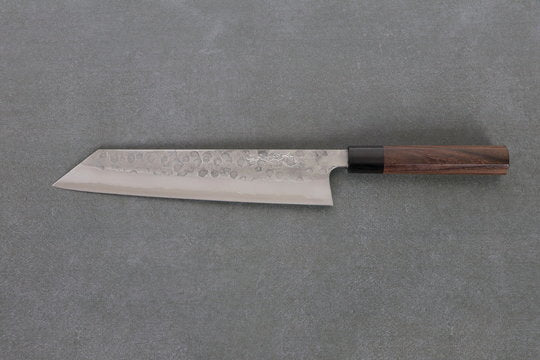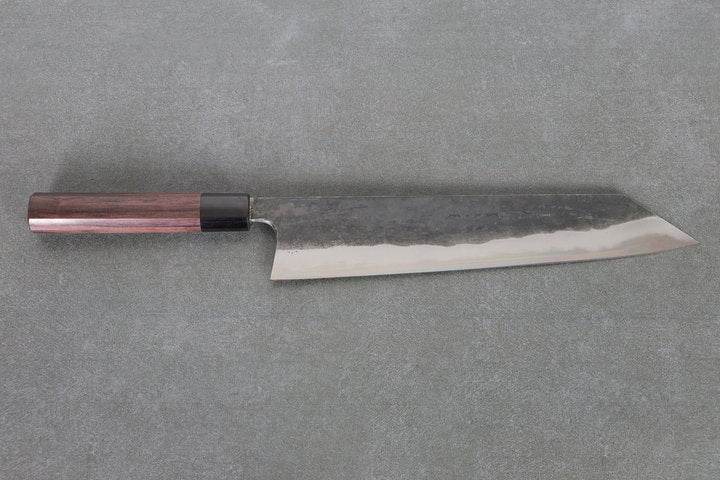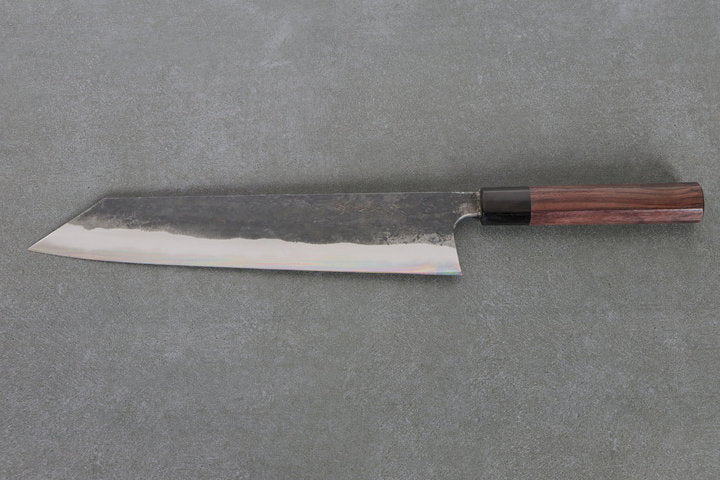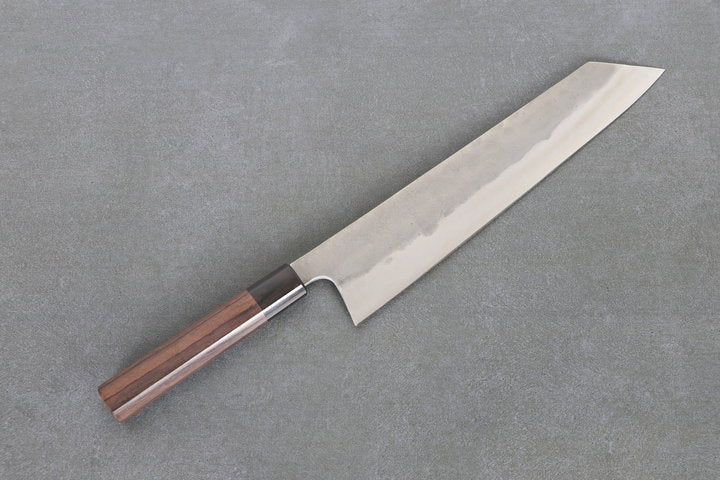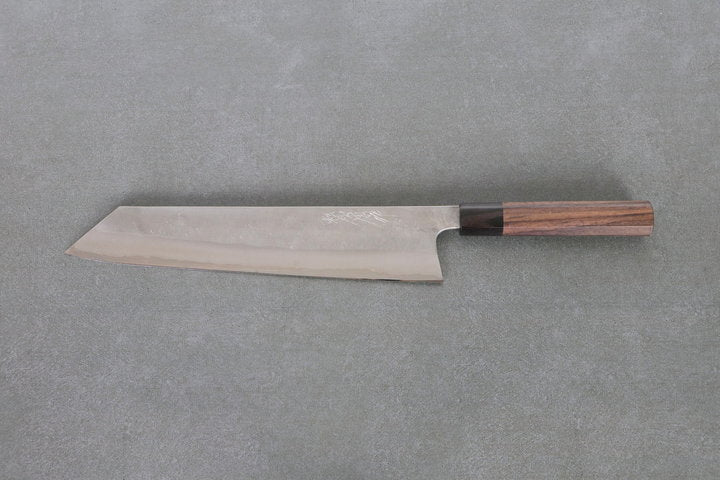Kiritsuke knife from Japan
Basically, the Kiritsuke knife can be classified as a fish knife, because it was originally developed for this purpose. Nevertheless, in the meantime, some characteristics have developed that make the Kiritsuke knife a special but universally applicable type of knife.
From the use as a sushi knife or generally as a fish knife, over the processing of vegetables up to the use as a meat knife, this blade type with the characteristic Tanto point (like also with the Bunka knife) is a popular tool from the world of the Japanese kitchen knives.
The Kiritsuke knife through the ages
In the past, classic Kiritsuke knives were mainly offered as single-edged knives. In this form are often described as a hybrid of sushi knife and Usuba. This mix results in the special look of the Kiritsuke knife type.
The tapered blade is excellent for removing skins and tendons from meat and cutting fish, but at the same time Kiritsuke chef's knives are also ideal for processing vegetables.
So traditionally, the Kiritsuke was mostly single-edged, but today you can also find numerous double-edged versions on the market.
This type of knife tends to have longer blades starting at 200mm. The reversed tip is also found on the Japanese bunka. Nevertheless, there are also differences.
Difference between Kiritsuke knife and Bunka knife
As described, the great similarity between Kiritsuke knives and Bunka knives is the characteristic Tanto tip. Nevertheless, the Bunkas originate from a fundamentally different purpose than Kiritsuke knives.
Bunka knives have always been seen as compact cooking knives, which are taken to work by fishermen in Japan, for example, in order to have the right tool for cutting fish on the water at hand.
Kiritsuke knives with the longer blades are more likely to be left in the kitchen, as they are usually equipped with longer blades and are therefore less handy.
Also, their field of application is wider - so large vegetables or meat can be processed, even the preparation of sashimi dishes is no problem with the Kiritsuke knife. However, if you are looking for a pure vegetable knife, you are better off with a Usuba or Nakiri knife.
Japanese Kiritsuke knives: Hand-forged special knives for processing fish
The cutting edge in the rear blade area of the Kiritsuke knife is flat and can therefore be used like an Usuba or Nakiri knife, but the blade length is significantly longer than Usubas, which also results in different handling. Large Kiritsuke knives from 240mm can usually perform all cuts for which Yanagibas are also used.
Very fine cutting of fish fillets for sushi and sashimi dishes is no problem and with a little practice you can achieve very thin cuts with the Kiritsuke knife. Kiritsuke knives are usually available in blade lengths from 210 mm to 330 mm.
Double sided Kiritsuke knives
Double-sided Kiritsuke can be described as a combination of a Nakiri knife and a Sujihiki. It is a very versatile knife that can be used to perform many of the tasks normally done with a gyuto kitchen knife.
The double-edged Japanese Kiritsuke is available in a variety of styles. From knives with a blade profile identical to the single-edged kiritsuke, to tall rectangular versions that look like a long nakiri with a "reverse tanto" tip / "clipped point", to knives that look like a combination of kiritsuke and gyuto, many variations have emerged here over the centuries.
Kiritsuke knives are diverse
Like all blade styles in our knife store, the Kiritsuke knife is available in a variety of styles. Thus, these chef's knives are available in different sizes, with different steel and weight, different materials, different blade lengths handle variations.
However, in addition to these distinguishing features, a distinctive feature of the Kiritsuke knife is that the blade shape of different brands can be very different in geometry. Depending on the shape, Kiritsuke knives are still designed purely for cutting fish or as Japanese all-purpose chef's knives for a wide variety of foods, such as meat.
Kiritsuke Knife Sizes
The Kiritsuke knife is a versatile knife that can be used for tasks normally done by the Japanese Yanagiba (for sushi) and Usuba, namely cutting fish and thin slices of vegetables.
The Kiritsuke is available in various blade lengths, ranging from 210 mm to 330 mm. The longer the blades, the more precise and longer draw cuts can be made when cutting, for example, a fish fillet, as is normally done with the Yanagiba.
The selection of the size of the Kiritsuke knife is therefore based on what is mainly to be cut.
Kiritsuke knife shape
The Kiritsuke has a sword-like shape with a long, flat blade, a straight edge and an angled tip. The blade is straighter than that of a Japanese Yanagiba and longer than that of the Usuba - the classic Kirituke knife can be seen as a combination of the two. The traditional Kiritsuke Yanagiba (also called Kensaki Yanagiba) has a similar profile, but has a wider blade and a flatter edge than the Kiritsuke Yanagiba. The heel of the Kiritsuke is virtually flat and can be used just like an Usuba. The flat profile of the Kiritsuke knife is best for cutting thin slices of vegetables. The angled tip of the knife is useful for precise cutting, and the long blade allows you to cut through raw fish with a pull cut.
Kiritsuke knives with a single-edge grind
Many Kiritsuke models have a single-edge grind, meaning the blade is ground on only one side. The other side of the blade is slightly concave, which gives the Kiritsuke a unique non-stick property that makes it easy to remove paper-thin slices of vegetables, meat or sashimi without sticking to the blade.
When using a Kiritsuke knife with a single-edge grind, the cutting edge of the blade only lightly touches the food being sliced, preserving the natural freshness, flavor and texture of the food as it is sliced.
However, knives with a single-edge grind require learning how to cut straight with this grind, so some experience is beneficial here. Right-handed Kiritsuke knives tend to pull to the left when cutting, while left-handed knives tend to pull to the right.
What steel should I choose for my Kiritsuke knife?
Basically, when buying a Kiritsuke knife, you have a choice between carbon steel and stainless steel. The choice of steel determines the blade's edge retention and sharpness, corrosion and rust resistance, and overall durability. You can first weigh which of these factors are most important to you, and then narrow down your choices.
Carbon Steel Kiritsuke Knife
A carbon steel blade is easier to sharpen and retains its sharpness longer, but it requires more maintenance because it is susceptible to rust and corrosion. Over time, a patina will form on a carbon steel knife. Popular and well-known options include white steel (shirogami) and blue steel (aogami).
Kiritsuke stainless steel knives
Stainless steel blades are generally less expensive, tougher, less prone to chipping, and more corrosion resistant, but are harder to sharpen (though with practice this is not a problem) and dull more quickly. Popular options include VG10 or AUS10.
What handle do I choose for my Kiritsuke knife?
The handle of the Kiritsuke knife determines how balanced the knife is in the hand and how comfortable it is to use in the kitchen.
The decisive factor is how the knife is normally held in the hand. If the knife is primarily held by the handle by the cook, a molded or tapered western style handle will feel more comfortable and familiar than a classic Japanese handle.
Many traditional Kiritsuke knives of true masters have a Japanese style handle made of wood.


